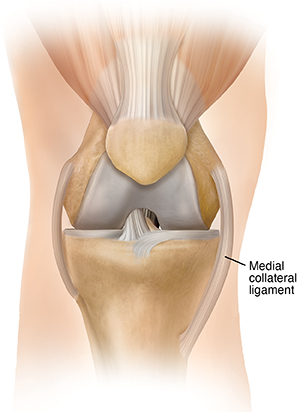Understanding Medial Collateral Ligament Sprain
The knee is a complex joint where the thighbone (femur) meets the shinbone (tibia). Strong tissues called ligaments connect these bones together. Ligaments also keep the bones aligned so the knee bends only how it is supposed to. The medial collateral ligament (MCL) runs across the knee joint on the medial (inner) side of the leg. Injury to this ligament may be very painful. The knee may also not work the way it should.

Causes of an MCL sprain
An MCL sprain often happens when the knee joint is pushed beyond its normal range of motion. It's most common during a blow to the knee from the outside, pushing the knee inward. It may also happen if the knee is forced into a twist. These movements stretch and tear the MCL. Other parts of the knee may be damaged along with the MCL.
Knee sprains are graded by the amount of ligament damage.
Symptoms of an MCL sprain
These include:
Treatment for an MCL sprain
Treatment will depend on the severity of the sprain and whether there is damage to other parts of the knee. Options often include:
-
Rest. This allows the knee to heal. Don't do any activities that stress the knee. Crutches, a knee brace, or both may also be recommended for a short time.
-
Cold packs and elevation of the knee. These help reduce swelling and relieve pain.
-
Compression. The knee may be wrapped with a bandage to help reduce swelling.
-
Medicines. These help relieve pain and swelling.
-
Exercises. These help improve the knee’s stability, strength, and range of motion.
If the injury is severe or several parts of the joint are involved, surgery may be an option. Surgery repairs the MCL and any other damaged structures.
When to call your healthcare provider
Call your healthcare provider right away if you have any of these:
© 2000-2024 The StayWell Company, LLC. All rights reserved. This information is not intended as a substitute for professional medical care. Always follow your healthcare professional's instructions.